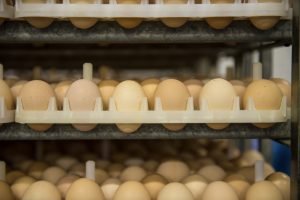The current outbreak of highly pathogenic avian influenza (HPAI or “bird flu”) in the United States and resulting egg price increases have caused the chicken industry to closely examine a Food and Drug Administration (FDA) policy that forces the broiler industry (broilers are chickens raised for meat) to destroy perfectly nutritious and safe eggs. The National Chicken Council today petitioned FDA to reverse or modify this policy.
“In light of the pressure the current HPAI outbreak is putting on the nation’s egg supply, FDA should revisit the use of safe, affordable, and nutritious surplus eggs available for use by egg breakers and their customers.
“Already faced with record egg prices, consumers might be hit even harder in their wallets as we head into the Easter season unless FDA provides us with a pathway to put these eggs to good use,” noted Ashley Peterson, Ph.D., NCC senior vice president of scientific and regulatory affairs.
Background
Due to fluctuating market conditions, broiler hatcheries, in some instances, have more eggs on hand than what they want to hatch. These are known as “surplus” hatching eggs. Prior to 2009 when FDA implemented new rules, broiler producers were able to sell these surplus eggs to egg processors, known as “breakers,” to be pasteurized (cooked) and used in egg products.
 When eggs are delivered from a breeding farm to a broiler hatchery, they are stored in a room kept at 65°F before they are placed in incubators to be hatched. Research has shown this is the most ideal temperature to store these eggs prior to incubation – warmer temperatures would induce the incubation process too soon and colder temperatures comprise the viability of an eventual hatch. But the 2009 FDA rule, which was focused on the safety of “table eggs,” or the eggs you buy in your grocery store, stated that all eggs intended to be sent to breaking facilities for eventual pasteurization must be kept at 45°F within 36 hours after being laid.
When eggs are delivered from a breeding farm to a broiler hatchery, they are stored in a room kept at 65°F before they are placed in incubators to be hatched. Research has shown this is the most ideal temperature to store these eggs prior to incubation – warmer temperatures would induce the incubation process too soon and colder temperatures comprise the viability of an eventual hatch. But the 2009 FDA rule, which was focused on the safety of “table eggs,” or the eggs you buy in your grocery store, stated that all eggs intended to be sent to breaking facilities for eventual pasteurization must be kept at 45°F within 36 hours after being laid.
As a direct result of the 2009 FDA rule, broiler producers stopped selling surplus hatching eggs to egg breakers and instead are forced to render or throw these eggs away, often at an additional cost.
FDA never suggested these surplus broiler eggs were unsafe or that pasteurization was ineffective. The FDA rule was focused on table eggs, which are raw products and present a very different risk profile than pasteurized surplus broiler eggs. In fact, under FDA’s rule, eggs that fail to meet certain requirements can be sent to egg breakers to be pasteurized, which is exactly what NCC is asking for now for broiler hatching eggs. As such, NCC objected to FDA’s rule when it was first implemented.
Egg products are defined by the U.S. Department of Agriculture (USDA) as “eggs that are removed from their shells for processing.” The processing of egg products includes breaking eggs, filtering, mixing, stabilizing, blending, pasteurizing, cooling, freezing or drying, and packaging. This is done at USDA-inspected facilities under the oversight of federal inspectors. Liquid, frozen, and dried egg products are widely used by food manufacturers and the foodservice industry and as ingredients in items such as salad dressings, bread, cake mix, pasta, pancake mix, mayonnaise, ice cream, pie crusts, sauces, and many other everyday food products.
Because egg products are pasteurized, they are ensured a high level of food safety. A 2020 joint FDA/USDA risk assessment confirmed these products present extremely low public risk due to the “extremely high pasteurization efficiency” of the egg breaking pasteurization process.
Current Situation
More than 58 million birds have been culled since HPAI was first detected in 2022, with the majority of them being egg-laying chickens.
These price spikes and supply disruptions are putting tremendous strain on the shell and egg products industries, and the impact has already begun to trickle down and impose hardships on restaurants, food manufacturers and consumers.
“With the recent risk assessment affirming their safety, we request FDA exercise its enforcement discretion to allow surplus broiler eggs to be sent for breaking without needing to meet the current refrigeration requirements,” the petition urged.
Granting NCC’s request would release almost 400 million safe and nutritious surplus eggs into the egg breaking supply each year, helping to ease costs and inflationary pressures.
“Despite sharp inflation and shocks to the egg supply, hundreds of millions of excess eggs are being wasted when they could be sold safely in the breaking market. Surplus hatching eggs should be made available for sale to egg breakers who can pasteurize them under FSIS jurisdiction into safe and wholesome egg products. This would reduce input costs for food made with egg products, and alleviate prices for both table eggs and egg products.”
NCC’s petition can be found here.

